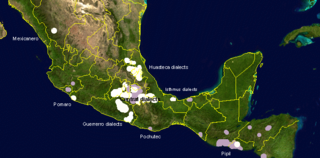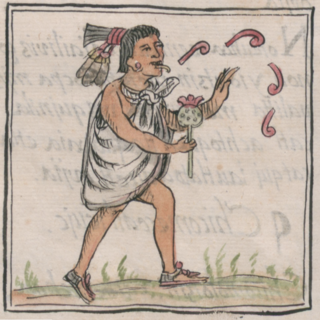
Morris Swadesh was an American linguist who specialized in comparative and historical linguistics.

The Nahuan or Aztecan languages are those languages of the Uto-Aztecan language family that have undergone a sound change, known as Whorf's law, that changed an original *t to before *a. Subsequently, some Nahuan languages have changed this to or back to, but it can still be seen that the language went through a stage. The best known Nahuan language is Nahuatl. Nahuatl is spoken by about 1.7 million Nahua peoples.

The Otomi are an indigenous people of Mexico inhabiting the central Mexican Plateau (Altiplano) region.

Otomi is an Oto-Pamean language spoken by approximately 240,000 indigenous Otomi people in the central altiplano region of Mexico. Otomi consists of several closely related languages, many of which are not mutually intelligible. The word Hñähñu has been proposed as an endonym, but since it represents the usage of a single dialect, it has not gained wide currency. Linguists have classified the modern dialects into three dialect areas: the Northwestern dialects are spoken in Querétaro, Hidalgo and Guanajuato; the Southwestern dialects are spoken in the State of Mexico; and the Eastern dialects are spoken in the highlands of Veracruz, Puebla, and eastern Hidalgo and villages in Tlaxcala and Mexico states.

La Cañada is a small town in the municipality of Cortazar, in the state of Guanajuato, Mexico. City elevation is 1 mile (5643 feet) above sea level; with a population of about 2,400. Founded in 1612, La Cañada lies between the hills of La Gavia and El Culiacán. The word Cañada refers to the Spanish word for land between two elevated bodies of the earth; Caracheo comes from the Purépecha word carachi, which means dried water.
Northwestern Otomi is a Native American language of central Mexico.
Sierra Otomia.k.a.Highland Otomi is a dialect cluster of the Otomi language spoken in Mexico by ca. 70,000 people in the highlands of Eastern Hidalgo, Western Veracruz and Northern Puebla. The speakers themselves call the language Yųhų or Ñųhų. Lastra 2001 classifies it as an Eastern Otomi language together with Ixtenco Otomi, Tilapa Otomi, and Acazulco Otomi. The three varieties of Sierra Otomi—Eastern Highland, Texcatepec, and Tenango—are above 70% lexically similar; the Eastern Highland dialects are above 80%, and will be considered here.
The grammar of the Otomi language displays a mixture of elements of synthetic and analytic structures. Particularly the phrase-level morphology is synthetic, whereas the sentence-level is analytic. Simultaneously, the language is head-marking in terms of its verbal morphology, but not in its nominal morphology, which is more analytic. Otomi recognizes three large open word classes of nouns, verbs, and particles. There is a small closed class of property words, variously analyzed as adjectives or stative verbs.
Temoaya Otomi, also known as Toluca Otomi or Otomi of San Andrés Cuexcontitlan, is a variety of the Otomi language spoken in Mexico by ca. 37,000 people in and around the municipality of Temoaya, and in three communities within the municipality of Toluca: San Andrés Cuexcontitlán, San Pablo Autopan and San Cristobal Huichochitlan. The two varieties are quite different. The speakers themselves call the language Ñatho. Lastra (2001) classifies it as a southwestern dialect along with the dialects of Mexico state. Lastra also notes that the endangered Otomí dialect of San Felipe in eastern Michoacán is most similar to the Otomí spoken in San Andrés Cuexcontitlan.
Classical Otomi is the name used for the Otomi language as spoken in the early centuries of Spanish colonial rule in Mexico and documented by Spanish friars who learned the language in order to catechize the Otomi peoples. During the colonial period, many Otomis learned to write their language in Roman letters. As a consequence, a significant number of documents in Otomi, both secular and religious, exist from the period, and the most well-known documents are the Codices of Huichapan and Jilotepec. Text in classical Otomi is not easily accessible since the Spanish speaking friars failed to differentiate the varied vowel and consonant sounds of the Otomi language.

Nahuatl, Aztec, or Mexicano is a language or, by some definitions, a group of languages of the Uto-Aztecan language family. Varieties of Nahuatl are spoken by about 1.7 million Nahua peoples, most of whom live mainly in Central Mexico and have smaller populations in the United States.
Eastern Peripheral Nahuatl is a group of Nahuatl languages, including the Pipil language of El Salvador and the Nahuatl dialects of the Sierra Norte de Puebla, southern Veracruz, and Tabasco :
Western Peripheral Nahuatl is a group of Nahuatl languages of Western Mexico. They are:
Central Nahuatl is a group of Nahuatl languages of central Mexico, in the regions of central Puebla, Tlaxcala, central Veracruz, Morelos, Mexico State, and Guerrero.
Central Otomi is a Native American language spoken by 10,000 in San Felipe Santiago and in several neighboring towns in the Mexican state of Mexico, such as Chapa de Mota and Jilotepec de Abasolo. Also called 'State of Mexico Otomi', there are other varieties spoken in the state, such as Temoaya Otomi. The autonym is Hñatho or Hñotho.
Tilapa Otomi is a seriously endangered native American language spoken by less than a dozen people in the village of Santiago Tilapa, between Toluca and the DF in Mexico State. It has been classified as Eastern Otomi by Lastra (2006). but in reality "Eastern Otomi" in Lastra's classification is a broader term for a "conservative variety". It is a language closely related to Acazulco and Atlapulco Otomi. It also shows a number of idiosyncratic innovations which make it stand as a different language, probably the closest one to Colonial Otomi. Its system of verbal conjugations is highly complex compared to the Mezquital varieties.
Ixtenco Otomi, also known as Tlaxcala Otomi, is a native American language spoken in the town of San Juan Bautista Ixtenco in the state of Tlaxcala, Mexico. It has been classified as Eastern Otomi by Lastra (2006). Lastra considers Ixtenco Otomí to be a very conservative dialect.
Santa Ana Hueytlalpan Otomi is a native American language spoken in Santa Ana Hueytlalpan town of Tulancingo de Bravo municipality of Hidalgo, Mexico. It has been classified as Eastern Otomi by Lastra (2006), but is not included in Ethnologue.
San Jeronimo Acazulco Otomi, or Ocoyoacac Otomí, is a moribund and seriously endangered dialect of the Otomi language spoken by a hundred or so people in the town of San Jerónimo Acazulco in Ocoyoacac, Mexico State.

San Jerónimo Acazulco is a town and community in the municipality of Ocoyoacac, Mexico State, Mexico. Once an agricultural community, the economy of the ejido is now primarily based on tourist commerce. It is within La Marquesa National Park.






